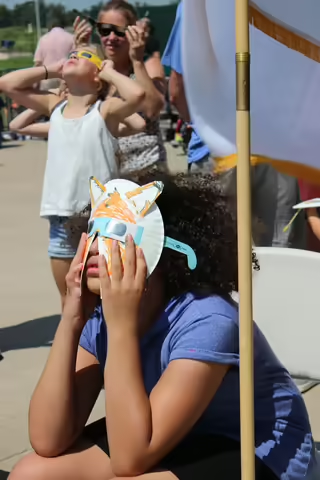
On April 8, 2024, parts of southern Illinois will darken as the moon passes in front of the sun causing a total eclipse. The eclipse has about a 115-mile-wide path cutting northeast across North America from Mexico through Maine. The central line, where the eclipse will last several minutes, will pass through southern Illinois, including Carbondale.
A total eclipse occurs when the moon is directly between the sun and earth, and the moon is at the right distance from the earth to be the same size in the sky as the sun. The moon is about 400 times smaller in width than the sun, but in the case of a total eclipse, the sun is 400 times farther away. Total solar eclipses happen about two times every three years.
When the moon is between the earth and sun but the three entities are not perfectly lined up, a partial eclipse may happen. An annular eclipse occurs when the moon is between the sun and the earth but is farther away. Because it is farther away, it will not completely cover the sun, so a bright ring around the moon is present.
Why don’t we see eclipses more often?
Even though the moon travels between the sun and earth every month, we don’t often experience an eclipse. This is because the moon’s orbit around the Earth is tilted. Most of the time it isn’t in a direct line between the earth and sun, and therefore does not cast a shadow on earth during the new moon period.
Eclipse spectacles
During a total eclipse, other phenomena such as Bailey’s Beads may occur. Because the moon’s surface has high and low spots, sunlight may show past the low spots, creating small areas of bright light that look like beads. As the moon appears to move off the sun, a bright area of light will be present on the uncovered side. This is called a Diamond Ring.
Differences from the 2017 eclipse
In 2017, Illinois was in the path of another solar eclipse. The 2024 eclipse will be different in a few ways.
This time, the moon will be slightly closer, making the shadow about 45 to more than 50 miles wider. The time the total eclipse lasts will also be slightly longer. Also, because this eclipse is in April instead of August, the path will cross over North America differently.
Watch the eclipse safely
Looking at concentrated solar rays can damage the eye's retina. Never look directly at the sun. During the eclipse, wear proper eclipse-approved eyewear or solar filters that are approved for viewing an eclipse. Regular sunglasses will not be safe.
Do not look at any type of solar eclipse through an unfiltered optical device. Even if you have eclipse glasses or a solar viewer, these cannot be used through an optical device either due to the concentration of solar rays. There are special filters that may be used for optical devices, but you must make sure they are from a reliable manufacturer and have the proper certification.
Sources: NASA, the National Park Service
About the Blog
Naturalist News is a blog by University of Illinois Extension Master Naturalist staff and volunteers who bring you stories highlighting the individuals, places, wildlife and plants that make this state amazing. Join us each week to learn something new, be inspired and become connected to your own community by recognizing the amazing ways we are all intertwined.
Sign up for the Naturalist News email
About the Author
Duane Friend is the Illinois Master Naturalist coordinator and climate specialist with University of Illinois Extension. He has been with Illinois Extension since 1993. From 2011 to 2022 he served as an Environmental and Energy Stewardship Educator in Calhoun, Cass, Greene, Morgan and Scott counties. From 1997 to 2011, Friend was a Natural Resources Management Extension Educator, and prior to that, he was a unit-based educator. He has also been a County Executive Director for the Farm Services Agency, and a resource conservationist for a Soil and Water Conservation District.
